My Story of 3D Realms / Apogee Part II
This is Part 2 of 8 of my History of 3D Realms / Apogee series. When originally published, it was a single post, but over time WordPress ended up not liking a post that was 33,000 words long. This segment covers 1988-1991.

The true release dates of these 1988 releases is lost to time. None of us really remember what the proper dates are at this point. If for some reason you happen to have verifiable info proving the date of any of them, please let me know. If this year had a theme, it was “The Trivia Year”.
Word Whiz
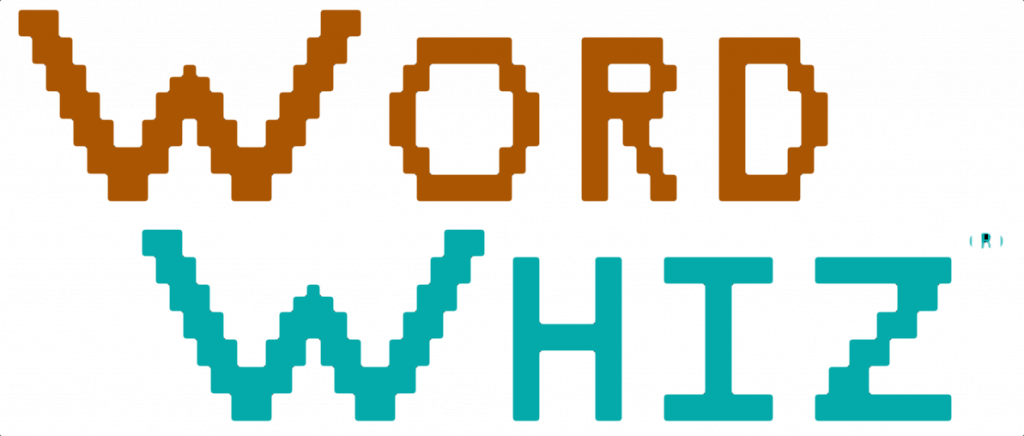
Release Date: Unknown 1988
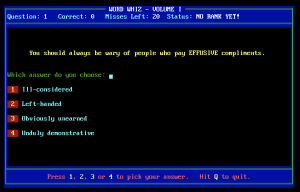 Word Whiz was a text based trivia game released by Scott Miller. There’s not a lot of info to divulge on this one. It was a 100% text based trivia game. That pretty much covers it.
Word Whiz was a text based trivia game released by Scott Miller. There’s not a lot of info to divulge on this one. It was a 100% text based trivia game. That pretty much covers it.
It was discontinued ages ago. Was released as freeware on 23 Dec 2005, and then re-released again with source code on 20 Mar 2009. It is still available on the 3D Realms FTP site. It is also available to play online over at The Internet Archive.
Current Status: Freeware
Word Whiz Links: [ Freeware – 3DR FTP | Internet Archive ]

Trivia Whiz

A similar game to Word Whiz, only this time by George Broussard. This was originally released by George’s own company, “Micro/FX”, and later re-released by Apogee. It’s pretty much the same thing as Trivia Whiz. I even remember one of them referring to this as the “Trivia game engine” – hahaha. Anyway, it was discontinued ages ago, and released as freeware on 23 Dec 2005. You can download the freeware from our FTP site. It is also available to play online over at The Internet Archive.
Current Status: Freeware
Trivia Whiz Links: [ Freeware – 3DR FTP | Internet Archive ]

Trek Trivia
Release Date: Unknown 1988
Similar to the other two Whiz games, except this one was all about Star Trek, and written by Scott Miller. Used the same game engine, too. After it was released, Apogee was threatened legally by Paramount over this title due to not having a license for Star Trek. Rather than fight the suit, Apogee withdrew distribution to the title, and relinquished all legal claim to the game. Due to that legal issue, I will not be linking to the game, nor providing a screenshot.
Current Status: Abandoned

Star Trek: TNG Trivia
Release Date: Unknown 1988
Similar to Scott’s Trek Trivia, this was about Star Trek: The Next Generation. This one was by George Broussard through his own Micro/FX company. It too had the same legal threat and was withdrawn as a result. I will not link to this game nor provide a screenshot for the same reason as the last entry.
Current Status: Abandoned
A note about Trivia Whiz & Star Trek: TNG trivia. Our notes say they were released in 1988, yet the games themselves say 1990 on them. Either way, the date is lost to time, but I wanted to present that as a footnote for completeness’ sake.

There wasn’t a lot of new releases in 1989, as this was when the followups to Kroz were released – or produced. Additionally, while our notes say that Adventure Fun Pack was released in 1986, there’s some websites that list it as 1989. Given we do not have proper release date info for most of the 80’s releases, I cannot refute it, but I wanted to mention this just the same. Also, this is the last year when we don’t know the true release dates for any of the titles.
Caves of Thor

Release Date: Unknown 1989
Also known as “The Thor Trilogy”, this is a series similar to Kroz, in that it’s an ASCII adventure game. Oddly enough, despite the series having the name “The Thor Trilogy”, it was mostly known as the episode name of the first game, “Caves of Thor”. Other games didn’t do that, not quite sure why that happened here. The three episodes that comprised the full game were titled “Caves of Thor”, “Realm of Thor”, and “Thor’s Revenge”.
From a gameplay standpoint, you can see games from this era progressing on from Kroz, but the ASCII beginnings of the company are still here in force. This was done by Todd Replogle, later known for Duke Nukem.
This was officially by Todd’s “Scenerio Software” label – it was his first game for Apogee. The game was later released as freeware on 23 Dec 2005. You can still download the freeware from our FTP site, and the game is playable online over at The Internet Archive.
Current Status: Freeware
Caves of Thor Links: [ Freeware – 3DR FTP | Internet Archive ]

Super Game Pack
Release Date: Unknown 1989
This was a compilation of several of the earlier titles from the catalog (despite the company only existing for a couple of years at this point). There were no new titles here, this was just a “Greatest Hits” of sort. The titles included here were “Asteroid Rescue”, “Block Five”, “Raiders of the Lost Mine”, “Rogue Runner”, Trek Trivia (Episode 1), & Word Whiz (Episode 1). Due to the inclusion of Trek Trivia, this product was withdrawn when Trek Trivia itself was withdrawn.
Current Status: Withdrawn, unavailable

1990 was another big year for Kroz, as most of the sequels for Kroz were released this year. However, we expanded into other titles and developers here a bit more (with one huge one). This is the year we say goodbye to the “no release date” (mostly). Things will start having some proper dates to them from here.
Monuments of Mars
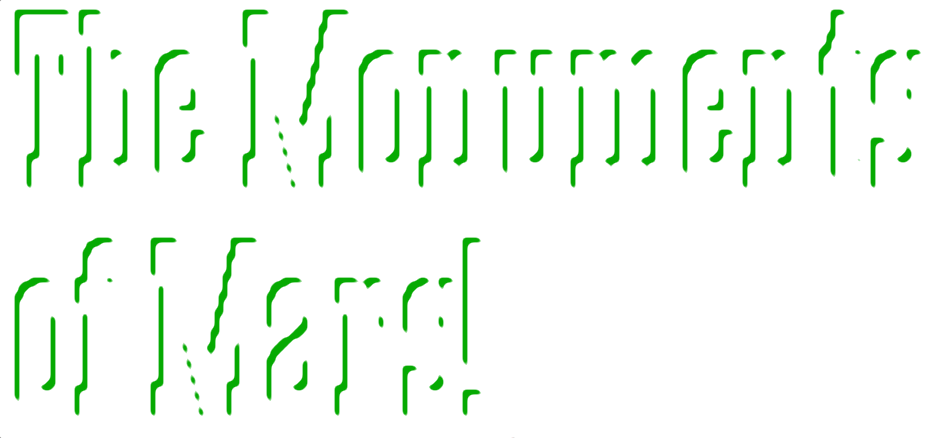
The second game by Todd Replogle through his Scenerio Software company. This is a platform game similar to what Apogee is most known for (Keen, Duke), but not quite there yet – but you can definitely see where the company was going here conceptually. This was the first such game like this in the company history. Prior to this everything was a text game (Trivia titles), or an ASCII title (Kroz, etc).
Mars was discontinued ages ago, and was re-released as freeware on 20 Mar 2009.
Current Status: Freeware
Links: [ Freeware – 3DR FTP | 3D Realms Site ]

Pharaoh’s Tomb

This is a CGA platformer written by George Broussard and put out through his own Micro/FX company. It was later to become a purely Apogee game. It is similar to Monuments of Mars in feel, but was developed separately and technically different engines. George himself said this on Twitter.
This is the game that George famously spelled his name wrong in his own game – including the two point releases (there was a 2.0 & 3.0 version too!). It was discontinued ages ago, and was released as freeware on 20 Mar 2009.
Current Status: Freeware
Updates: 2.0 – Unknown, 3.0 – Unknown
Links: [ Freeware – 3DR FTP | 3D Realms Site ]

Commander Keen: Invasion of the Vorticons

Release Date: 14 Dec 1990
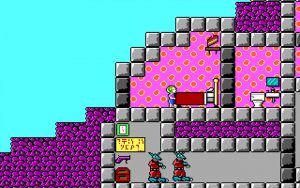
This is where things started getting huge. It was the original trilogy of Commander Keen games by id Software titled “Invasion of the Vorticons”. The three individual episodes were titled “Marooned on Mars”, “The Earth Explodes”, & “Keen Must Die!”.
So much goodness started here. I don’t even know where to begin with Keen. It’s a legendary platformer, and launched the careers of many folks (at least independently anyway).
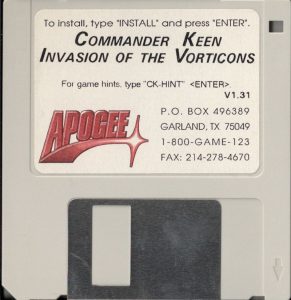 The game had a manually created alphabet that Tom Hall used to create signs and, if you could decipher it, clues. You can see this alphabet in the screenshot shown here – it’s a small yellow sign with red lettering. The alphabet key was never released by Tom, id, or Apogee as a standalone thing (although I’m told it appears in Keen 3 in game).. It wasn’t until later that I discovered that. I went over to id Software a bunch in the early days to shoot pool and whatnot. I spotted the sign in Tom’s office, made a copy, and we used it to send to customers who requested a translation key. Later on I put it online, and this alphabet key has appeared many places from that original copy I made of Tom’s sign. The image is shown below.
The game had a manually created alphabet that Tom Hall used to create signs and, if you could decipher it, clues. You can see this alphabet in the screenshot shown here – it’s a small yellow sign with red lettering. The alphabet key was never released by Tom, id, or Apogee as a standalone thing (although I’m told it appears in Keen 3 in game).. It wasn’t until later that I discovered that. I went over to id Software a bunch in the early days to shoot pool and whatnot. I spotted the sign in Tom’s office, made a copy, and we used it to send to customers who requested a translation key. Later on I put it online, and this alphabet key has appeared many places from that original copy I made of Tom’s sign. The image is shown below.
There’s some cool Keen fan art on an anniversary story for Commander Keen on the 3D Realms site here. Also, in 2006 I did an interview with Tom Hall as part of the Apogee Legacy interview series. It is still online, you can read it here.
Apogee/3D Realms sold Keen Vorticons in shareware from 14 Dec 1990 until 9 Jul 2020, when the original shareware deal between Apogee & id Software from thirty years ago was finally brought to a close.
Current Status: Still available, but from id Software directly.
Updates: v1.31 (23 Jan 1991) – Updates between 1.0 and 1.31 are unknown.
Links: [ Steam Page – id Software | 3D Realms Site ]
 1991 marks the first big year into new games, and new IPs. Apogee/3DR’s most legendary character (Duke Nukem) started this year, and we had a couple of sequels this year, too.
1991 marks the first big year into new games, and new IPs. Apogee/3DR’s most legendary character (Duke Nukem) started this year, and we had a couple of sequels this year, too.
Dark Ages


Release Date: Feb 1991
Dark Ages was the first game that Apogee released that truly matched the format of what we became known for – the 90’s side scrolling platformer. This was written by Todd Replogle and Scenario Software. Also on this were Allen Blum & Keith Schuler.
It also had an industry first; Dark Ages was the first ever shareware game to have Adlib music in the game – and not just PC Speaker “music”. I contacted Keith Schuler, who did the music for Dark Ages, and asked him if he had any memories of doing it. This is what he had to say. He speaks about a few of his earlier games in this story, too.
If memory serves, the Adlib card was released right around the time Chagunitzu was released, so I had some extra money on hand. I bought a decent new computer (a 386 with EGA), and later, an Adlib card. The PC gaming scene was growing a lot during this time, but audio was still really terrible. My hope was that an Adlib card would be a step towards PC games sounding as good as the NES games of the time. By now, I was working on Paganitzu, and aspired to add Adlib music to my new game. This wasn’t going to happen, unfortunately.

Chagunitzu had been written in Microsoft QuickBASIC. I had started learning and working in C, but I didn’t want to entirely rebuild Paganitzu from scratch in a new language. The deciding factor was the graphic library that came with Borland C, which had very few parallels to what came with QuickBASIC. Near the end of the project, I learned how to link Microsoft C modules into QuickBASIC (that’s how Paganitzu’s input routines were built), but very little of Paganitzu was written in C.
My Adlib card came with programming documentation and some bundled software: a utility called “Composer” for making music, and “Jukebox”, which came with a variety of professionally made songs to show off what the Adlib could do. They even had a version of Living Colour’s Cult of Personality in there. Jukebox and Composer used the same file format for songs, so you could load up the professionally made songs in Composer, or the play the songs you made in Jukebox. The programmer’s guide was incomprehensible to me: I had no education in audio theory, and I didn’t have an SDK (in C or BASIC) to talk to the sound card, so I would’ve had to write my own from scratch. It’s possible I could’ve done it in C, maybe, but Paganitzu was in BASIC. I was still in high school, mostly self-taught, and very isolated from users groups or the sorts of people I could work with to develop this stuff. The Internet and helpful sites like Stack Overflow were years away. My dad had brilliant programmer coworkers, and they supported me by giving me things like their old copies of Microsoft compilers after they upgraded, but these were professionals with day jobs and no real interest in video games. So, I was mostly figuring out how everything worked on my own. Ultimately, I decided that I wasn’t capable of building an Adlib SDK for Paganitzu.
 Along with having no training in the science of sound, I also had no training in music. But, I was trying to make an entire video game alone in my bedroom. All programming, art, design, and sound had to come from me. So, during the time between when I got my Adlib card, and when I decided that programming an Adlib SDK was out of scope, I was playing around in Composer and Jukebox, trying to learn how to make music and create a few pieces that could be used in Paganitzu. Composer was a lot like a MIDI sequencer, which meant I had a visual way to edit music. I would load one of the Jukebox songs, see how they did it, then try to replicate that in my own songs, using mouse and a computer keyboard instead of a MIDI keyboard. I didn’t know what a chord was, or what half of the Adlib’s instruments were supposed to sound like. I “brute force” composed music by putting some notes together, seeing what it sounded like, and rearranging everything until I had something that sounded like music. Fortunately, music is quite repetitive. Once you had a “riff” that sounded good, you could just copy-paste that until it was the length of a song.
Along with having no training in the science of sound, I also had no training in music. But, I was trying to make an entire video game alone in my bedroom. All programming, art, design, and sound had to come from me. So, during the time between when I got my Adlib card, and when I decided that programming an Adlib SDK was out of scope, I was playing around in Composer and Jukebox, trying to learn how to make music and create a few pieces that could be used in Paganitzu. Composer was a lot like a MIDI sequencer, which meant I had a visual way to edit music. I would load one of the Jukebox songs, see how they did it, then try to replicate that in my own songs, using mouse and a computer keyboard instead of a MIDI keyboard. I didn’t know what a chord was, or what half of the Adlib’s instruments were supposed to sound like. I “brute force” composed music by putting some notes together, seeing what it sounded like, and rearranging everything until I had something that sounded like music. Fortunately, music is quite repetitive. Once you had a “riff” that sounded good, you could just copy-paste that until it was the length of a song.
At some point, George or Scott provided me with an early look at Dark Ages. Todd was smarter than me and had figured out how to program the Adlib card, (and whatever he did was probably in C and therefore would’ve been difficult to integrate into Paganitzu.) The version of Dark Ages I saw was playing those songs that came with Jukebox. This meant that the music I had created in Composer was compatible, and since I wasn’t going to be able to use it, I offered it up to be used in Dark Ages.
Thanks a ton to Keith for allowing me to use the story in my blog here. The video shown below shows some of the music for the game if you’ve never heard it.
Unfortunately, Dark Ages had some tech issues as time went on, and was discontinued. Later released as freeware on 20 Mar 2009.
Current Status: Freeware. Oddly it’s listed on Steam, but you can’t get it there.
Links: [ Freeware – 3DR FTP | Dark Ages on Steam | Internet Archive ]

Jumpman Lives!
Jumpman Lives! was programmed by Dave Sharpless and his own “Shamusoft Designs” company. It was a clone of the game “Jumpman”. It didn’t last long, as Epyx, who owned Jumpman wasn’t thrilled, and due to that Apogee gave the rights to this game to Epyx. Epyx themselves eventually went bankrupt, and presumably the rights to Jumpman Lives! went to Bridgestone Media, who bought them in 1993. In 2020, not so sure who would technically own the Jumpman rights.
 It is a throwback to some of the earlier Apple // game play style I remember from that era. Always enjoyed it, but you die a lot in this one – A LOT! :)
It is a throwback to some of the earlier Apple // game play style I remember from that era. Always enjoyed it, but you die a lot in this one – A LOT! :)
There is an interview I did with Dave Sharpless many a moon ago about Jumpman and himself on the old legacy 3D Realms site.
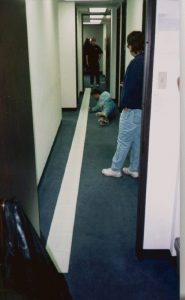 One thing I wanted to add here. We’ve gotten some notorious complaints about things over the years, but Jumpman probably achieved one of the most notable ones. We got this complaint in 1994 from a guy in Canada who was – shall we say – unhappy that we discontinued Jumpman Lives. He sent what can only be described as a manifesto of everything he thinks is wrong with society – something we helped contribute to by making a game he wanted unavailable. I’m going include a few small sections of the complaint here. A few of us tried to read it, but couldn’t make it through – it’s unreadable in its full form. The paper in 2020 is a bit faded. I’m surprised it’s actually readable at all given it’s been sitting in a filling cabinet since 1994. Still, here’s a few pics from it, and to the right is a photo taken during Rise of the Triad development when we stretched it out on the floor and tried to read it in tag-team “event”. :) I took the photo myself, and also in the shot are Jim Dose (standing), Joe Selinske (lying down), and Mark Dochtermann (in the distance). I still have the thing in 2020 as the following photo I took on 22 Oct 2020 shows. It’s not easy to hold something like that yourself and take the picture. ;)
One thing I wanted to add here. We’ve gotten some notorious complaints about things over the years, but Jumpman probably achieved one of the most notable ones. We got this complaint in 1994 from a guy in Canada who was – shall we say – unhappy that we discontinued Jumpman Lives. He sent what can only be described as a manifesto of everything he thinks is wrong with society – something we helped contribute to by making a game he wanted unavailable. I’m going include a few small sections of the complaint here. A few of us tried to read it, but couldn’t make it through – it’s unreadable in its full form. The paper in 2020 is a bit faded. I’m surprised it’s actually readable at all given it’s been sitting in a filling cabinet since 1994. Still, here’s a few pics from it, and to the right is a photo taken during Rise of the Triad development when we stretched it out on the floor and tried to read it in tag-team “event”. :) I took the photo myself, and also in the shot are Jim Dose (standing), Joe Selinske (lying down), and Mark Dochtermann (in the distance). I still have the thing in 2020 as the following photo I took on 22 Oct 2020 shows. It’s not easy to hold something like that yourself and take the picture. ;)
Current Status: See above
Links: [ Internet Archive ]

Duke Nukem

This is it, the first Duke Nukem game, and one I was a customer for – I bought this back in the day before I started working for Apogee. It’s a legendary game.
While the version of the character we know from Duke Nukem 3D isn’t here yet, there are parts of it that are. The look is mostly the same – the hair – the shirt. There’s no sunglasses, but it’s unmistakably Duke. Even Doctor Proton originated here, a character that didn’t really have a huge impact after this until the second add on pack for Duke Nukem Forever.
If you bought the game from us at any time past the first year, the title screen is spelled ‘Duke Nukum” – vs the traditional Duke Nukem. I love the so called “experts” who try and tell me I’m wrong about the spelling. Yes, the game shows as Nukum – but the proper spelling is Nukem.
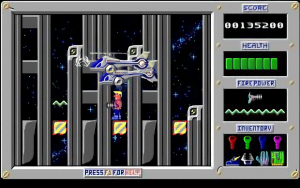 Here’s something I wrote AGES ago about the Nukem vs Nukum naming thing: There is frequently a great deal of confusion over the correct spelling of one of Apogee’s most prized characters, Duke Nukem. The original spelling for the name was “Duke Nukem”; however, during the code fix stage between v1.0 and v2.0 of the original game, Apogee found a character overseas named “Duke Nukem” that was thought to be copyrighted. So, for v2.0 of the original Duke game, the name was changed to “Duke Nukum.” Then, during the programming of the next Duke Nukem game (Duke Nukem II), it was discovered that the character they found overseas was not copyrighted after all — and so the original name was reinstated. “Duke Nukem” is also the spelling used in all successive games that featured the character. Unfortunately, there were no subsequent updates to the original Duke Nukem game, and therefore we did not correct the name back – it’s been sold as “Nukum” since Nov 1991.
Here’s something I wrote AGES ago about the Nukem vs Nukum naming thing: There is frequently a great deal of confusion over the correct spelling of one of Apogee’s most prized characters, Duke Nukem. The original spelling for the name was “Duke Nukem”; however, during the code fix stage between v1.0 and v2.0 of the original game, Apogee found a character overseas named “Duke Nukem” that was thought to be copyrighted. So, for v2.0 of the original Duke game, the name was changed to “Duke Nukum.” Then, during the programming of the next Duke Nukem game (Duke Nukem II), it was discovered that the character they found overseas was not copyrighted after all — and so the original name was reinstated. “Duke Nukem” is also the spelling used in all successive games that featured the character. Unfortunately, there were no subsequent updates to the original Duke Nukem game, and therefore we did not correct the name back – it’s been sold as “Nukum” since Nov 1991.
The rights to all the Duke Nukem games are currently held by Gearbox (since 2020). As far as I know, this game is not legally available to purchase anywhere right now.
Little known fact: The original name of the game was “Heavy Metal”.
Current Status: Unavailable, rights owned by Gearbox.
UPDATES: v2.0 – 1 Nov 1991
Links: [ 3D Realms Duke1 Page | Legacy 3DR Duke1 page ]

Paganitzu

Paganitzu is a CGA puzzle game written by Keith Schuler at his “Trilobyte Software” company. Back in the day, I loved this game, it was a true puzzle adventure game. It also was technically a sequel to a game called Chagunitzu, that Apogee had nothing to do with. Paganitzu looked a lot like the earlier game. It’s not quite a level pack – it’s not THAT similar. But if you knew one of the two games, then you’ll find the other very familiar.
There was a strategy guide that we started work on way back in the day called “The Tourist’s Guide to Paganitzu”, but it was never completed and abandoned. What little work we did on it can be seen in this PDF available on the legacy 3D Realms site.
There was a game later on in our company history that started off life as a sequel to Paganitzu (Realms of Chaos), but when it was released, those connections were removed. More on that later.
Finally, I did an interview back in 2006 with Keith Schuler as part of the Apogee Legacy interview series. It is still online, you can read it here.
Current Status: Still available for sale from 3D Realms.
Updates: v2.0 – 1 Dec 1991
Links: [ Paganitzu Steam Page | 3DR Paganitzu Page | Legacy 3DR Paganitzu Page ]
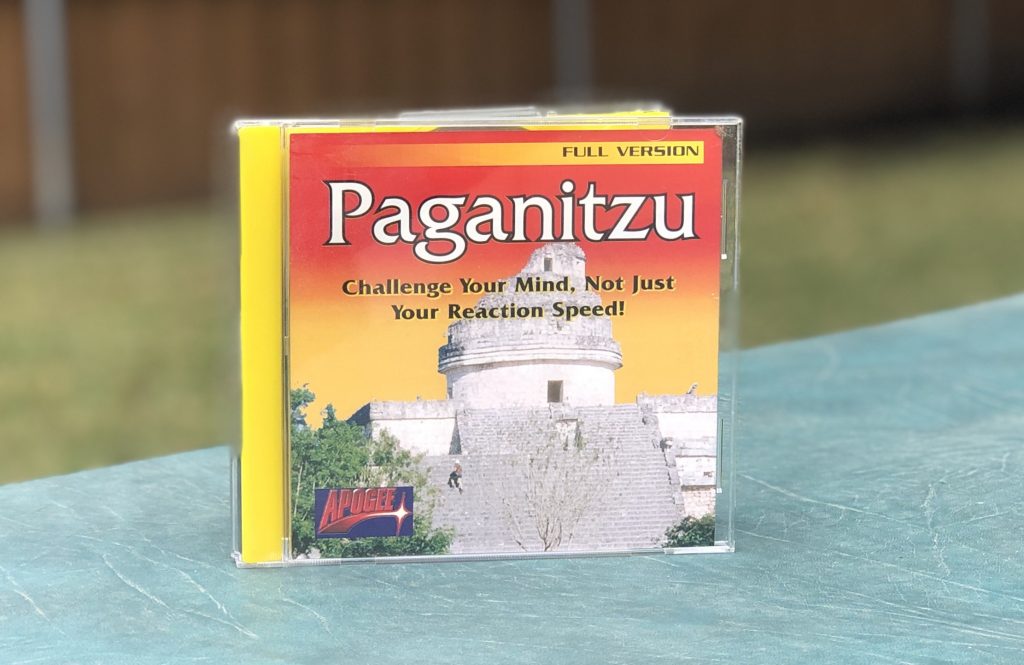

Arctic Adventure

Release Date: 9 Oct 1991
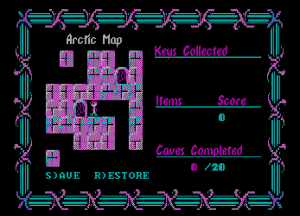 Arctic Adventure is a CGA platformer, and a sequel to Pharaoh’s Tomb. It was written by George Broussard. The original version of the game (v1.0) was published through his own Micro/FX company, but the v2.0 update was published through Apogee directly.
Arctic Adventure is a CGA platformer, and a sequel to Pharaoh’s Tomb. It was written by George Broussard. The original version of the game (v1.0) was published through his own Micro/FX company, but the v2.0 update was published through Apogee directly.
This title introduced a world map to the mix, something new at the time, we hadn’t had that in any other game to this point. You can see the world map to the right.
It was later released as freeware on 20 Mar 2009. It is also playable online at the Internet Archive.
Current Status: Freeware.
UPDATES: 2.0 – Unknown date
Links: [ 3D Realms FTP | 3DR Arctic Adventure Page | Internet Archive ]

Crystal Caves

Release date: 23 Oct 1991
 Crystal Caves is an EGA platformer written by Frank Maddin inspired by Miner 2049er. It’s puzzle based, as you had to find certain crystals to clear levels, and progress. The screenshot here is from the game’s “World map”, something first introduced in Arctic Adventure.
Crystal Caves is an EGA platformer written by Frank Maddin inspired by Miner 2049er. It’s puzzle based, as you had to find certain crystals to clear levels, and progress. The screenshot here is from the game’s “World map”, something first introduced in Arctic Adventure.
Crystal Caves holds what we believe to be a record, the longest amount of time between the original release of a game, and a patch. We updated the game in 2005, as Crystal Caves was not Y2K compliant. The problem there was that in 2005, if you played the game under certain conditions, your system clock would be set back 100 years. We tracked down Frank Maddin, who fortunately still had the game’s source code at this time. We found out that the portion of the code that was causing this was using a pre-compiled library, and we couldn’t fix it, because we didn’t have the source for that specific part. Our good old friend “hacking the EXE” came to the rescue, as we were able to hex edit the main EXE to remove references to that routine. That’s the version that we still sell to this day. :)
I did an interview back in 2006 with Frank Maddin as part of the Apogee Legacy interview series. It is still online, you can read it here.
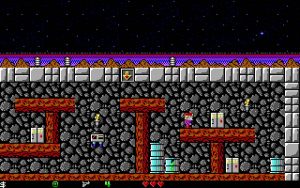 In September 2020 it was announced that an updated game called “Crystal Caves HD” was in production. There is a Youtube trailer for it. This game was published by Apogee Entertainment. This new version was released on 15 Oct 2020 – you can view the steam page for it here.
In September 2020 it was announced that an updated game called “Crystal Caves HD” was in production. There is a Youtube trailer for it. This game was published by Apogee Entertainment. This new version was released on 15 Oct 2020 – you can view the steam page for it here.
Current Status: Original version still available for sale from Apogee Entertainment
Updates: v1.0a – 24 Oct 2005
Links: [ OG Steam Page | 3DR Crystal Caves Page | Legacy 3DR Crystal Caves Page ]
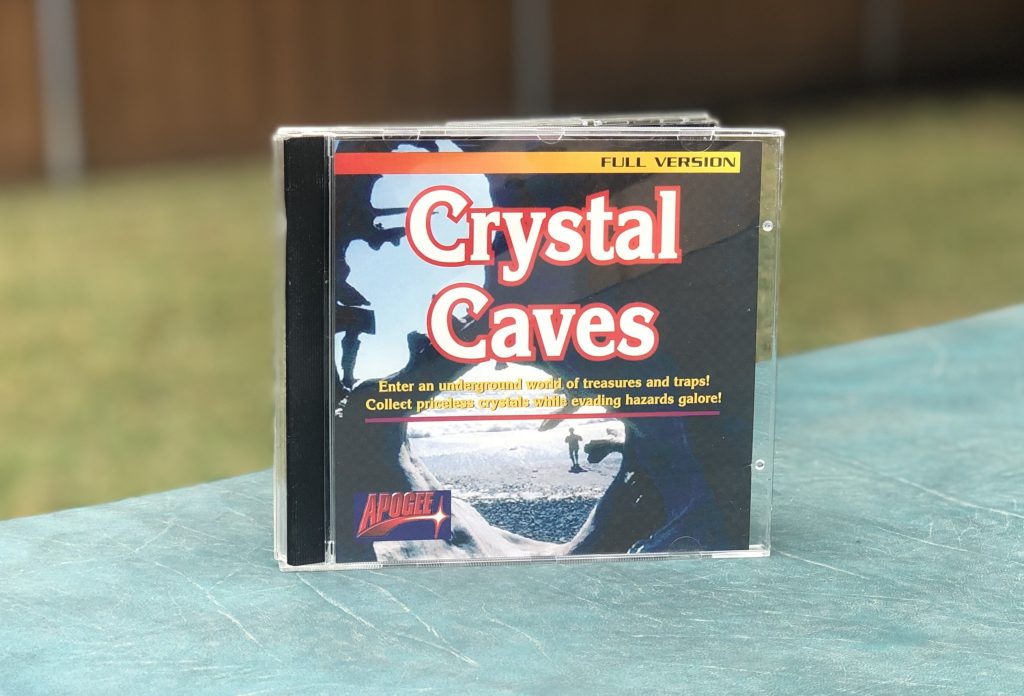

Commander Keen: Goodbye Galaxy!

Release Date: 15 Dec 1991

 The sequel series to the prior year’s Commander Keen. This was originally created as a trilogy, but the then id Software CEO wanted to take the third episode (Aliens Ate My Babysitter) and make it a standalone retail game, so this series was just two episodes, and not three, which was a bummer, as the price wasn’t any lower (that I recall).
The sequel series to the prior year’s Commander Keen. This was originally created as a trilogy, but the then id Software CEO wanted to take the third episode (Aliens Ate My Babysitter) and make it a standalone retail game, so this series was just two episodes, and not three, which was a bummer, as the price wasn’t any lower (that I recall).
The shareware episode of this game was the first appearance of the famed Dopefish. Episode V had Robo Red, another Keen character I really liked.
This was also the first game from Apogee that had music by Bobby Prince. Oddly enough despite my own personal affinity for Dopefish (who comes from Episode IV), I prefer Episode 5 of the series of all the Keen episodes. Speaking of Dopefish, I have an entire website for Dopefish online, complete in its 90’s design aesthetic. You can see that at http://www.dopefish.com. Heck, I even have a Dopefish twitter account.
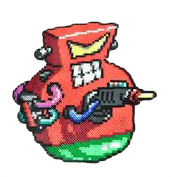 Speaking of Bobby Prince’s music, I want to tell a personal story about this game. Keen 4 was the game that made me get a sound card for the first time. Back when this game was new I worked at the computer repair department of Bell Atlantic. On the repair floor, guys would test sound stuff, and would use Apogee’s shareware games on the test computers because of the sound they made. I was over by one of the repair stations, and then had Keen IV on, and I watched for a minute, and fell in love with the music the game made. That day after work, I drove to some computer store (forget who now 30 yrs later), and bought my first Sound Blaster – just so I could hear the music from Keen IV. I already had the game, but no sound card, I was rockin’ PC Speaker only at that point.
Speaking of Bobby Prince’s music, I want to tell a personal story about this game. Keen 4 was the game that made me get a sound card for the first time. Back when this game was new I worked at the computer repair department of Bell Atlantic. On the repair floor, guys would test sound stuff, and would use Apogee’s shareware games on the test computers because of the sound they made. I was over by one of the repair stations, and then had Keen IV on, and I watched for a minute, and fell in love with the music the game made. That day after work, I drove to some computer store (forget who now 30 yrs later), and bought my first Sound Blaster – just so I could hear the music from Keen IV. I already had the game, but no sound card, I was rockin’ PC Speaker only at that point.
 So much of this game was enjoyable. So much so I’d love for it to come back on something like the Nintendo Switch without any kind of modifications, updates, or whatnot. I mean even just something as simple as “Keen dying” makes me laugh in 2020. So I’m ready for more Keen.
So much of this game was enjoyable. So much so I’d love for it to come back on something like the Nintendo Switch without any kind of modifications, updates, or whatnot. I mean even just something as simple as “Keen dying” makes me laugh in 2020. So I’m ready for more Keen.
This turned out to be the last (proper) Keen game released. There was one in-between the prior series and this one called “Keen Dreams“, but Apogee had nothing to do with that. There were two other appearances of Commander Keen over the years. The second was in 2019, when Bethesda tried to relaunch Commander Keen. It was received EXTREMELY poorly (even by Dopefish!), and was apparently discontinued in Summer 2020 after not ever having been released. The first time, however, did produce a released game. It was called “Commander Keen“, and was released for the Gameboy Color handheld. Neither Apogee/3D Realms or Tom Hall had anything to do with this. It was written by David Palmer, and published by Activision. It was released on 30 May 2001. It was not well received either, and it showed that you can’t really do Keen properly without Tom Hall. There’s more to read about this game on Wikipedia.
Apogee/3D Realms sold Keen Galaxy in shareware from 15 Dec 1991 until 9 Jul 2020, when the original shareware deal between Apogee & id Software from many a moon ago was finally brought to a close.
Current Status: Still available – from id Software
Updates: v1.4 (1 Feb 1992) – Updates between 1.0 and 1.4 are unknown.
Links: [ Steam Page – id Software | 3DR Keen Galaxy Page | Legacy 3DR Keen Galaxy Page ]

 |
 |


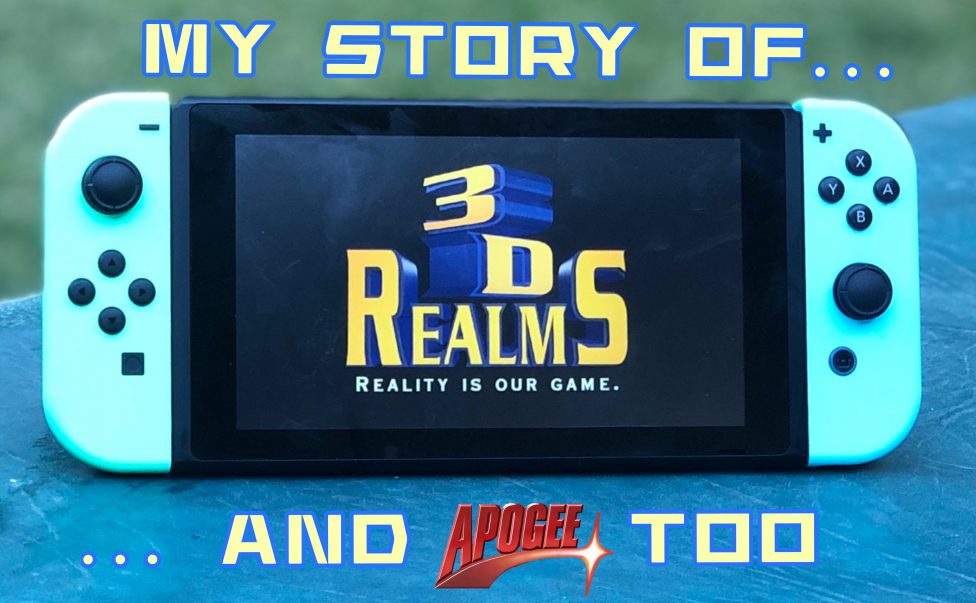








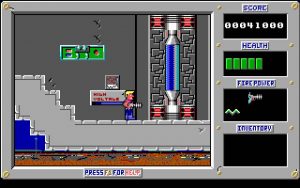
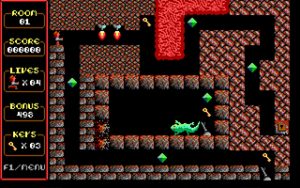
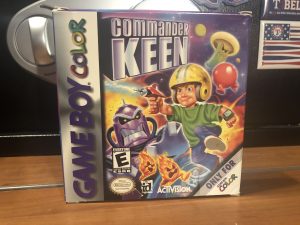
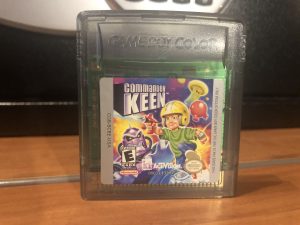
Join the Conversation
One minor correction: Commander Keen Episode 3: Keen Must Die included the full “standard galactic alphabet” in-game – the level on the secret island you have to ride Messie to reach has a schoolhouse at the top of the level, where the SGA is laid out with the Latin alphabet below. The only thing missing is the end-of-sentence symbol. I’m told it’s also present in Keen 6.